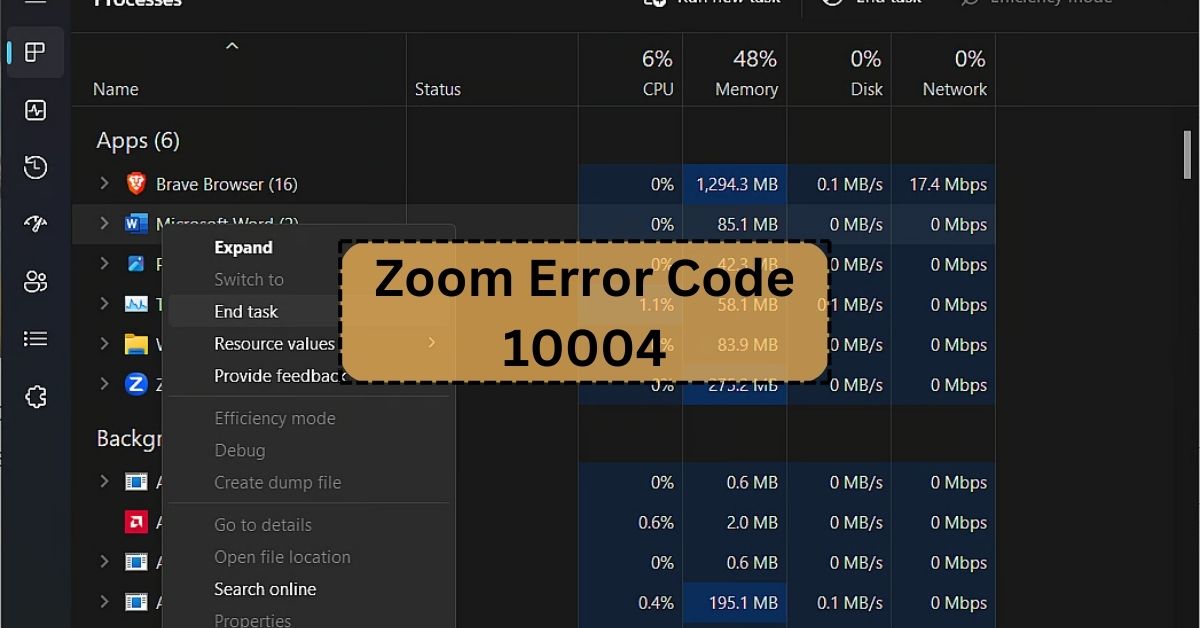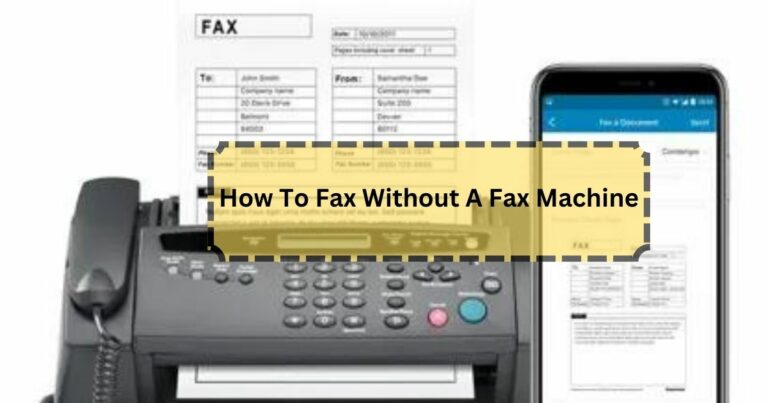In the modern age of digital communication, Zoom stands out as a beacon for seamless video conferencing. However, even the most robust platforms encounter challenges; among them is the vexing Zoom Error Code 10004.
Zoom Error Code 10004 occurs when the Zoom application faces challenges in updating itself. This can be due to network issues, problems with Zoom servers, firewall restrictions, or using an outdated Zoom client.
This extensive guide aims not only to unravel the complexities of this error but also to provide a comprehensive understanding of its causes and equip you with practical solutions to ensure your Zoom experience remains smooth and uninterrupted.
Understanding Zoom Error Code 10004 – Learn More About It!
The convoluted journey of troubleshooting Zoom Error Code 10004 transforms into a truly Herculean undertaking, amplifying the levels of frustration, especially when standing at the edge of consequential meetings or pivotal webinars.
\
This intricate error, akin to navigating a labyrinth of digital challenges, unfurls its mystifying complexities when Zoom endeavors to conduct a self-initiated update, only to find itself ensnared in the convoluted web of unforeseen barricades. These barriers create impediments, obstructing the establishment of a seamless connection to its servers.
In the plainspoken language, the heart of the matter lies in the incapacity of your Zoom software to independently orchestrate the requisite update, thereby casting an ominous and disconcerting shadow in the form of Error Code 10004.
This digital hiccup can disrupt the flow of productivity, rendering your Zoom application unable to synchronize with its servers, crucial for ensuring a smooth and up-to-date user experience.
As you grapple with this techno-quandary, it’s crucial to appreciate the multifaceted nature of the issue. Network connectivity, the lifeblood of online communication, can become a bottleneck, leading to the manifestation of Error Code 10004.
Simultaneously, Zoom’s servers might be undergoing maintenance or experiencing downtime, adding another layer to the complexity.
Amidst this digital labyrinth, potential solutions emerge, each akin to a carefully plotted turn in the maze. Checking the Zoom server status becomes the initial checkpoint to rule out server-related issues.
Updating the Zoom client, akin to equipping oneself with the latest map for navigation, involves ensuring that your Zoom application is armed with the latest features and security patches. Clearing the cache, a digital housekeeping task, proves effective in resolving potential errors arising from the accumulation of temporary data during frequent app use.
However, if these well-charted paths fail to lead to resolution, a decisive move involves a complete uninstallation and subsequent reinstallation of Zoom.
This serves as a digital reset, wiping the slate clean of any corrupted files or settings that might have contributed to the obstinate Error Code 10004.
In essence, the journey to resolve Zoom Error Code 10004 is akin to navigating a digital odyssey, where each step demands careful consideration and a methodical approach.
The ultimate goal is to emerge on the other side with a seamlessly functioning Zoom application, ready to facilitate your virtual collaborations without the looming specter of Error Code 10004.
What Causes Zoom Error Code 10004?
Before diving into the solutions, it’s crucial to explore the potential culprits behind Zoom Error Code 10004:
- 1. Network Connectivity Woes:
A weak or unstable internet connection can significantly hinder Zoom’s efforts to fetch updates, leading to the manifestation of the error.
- 2. Zoom Server Hiccups:
There are instances where the error crops up due to Zoom’s servers being temporarily down or undergoing maintenance, causing disruptions in the update process.
- 3. Firewall Restrictions:
Specific firewall settings on your device might inadvertently block Zoom’s access to servers, resulting in the error message.
- 4. Outdated Zoom Client:
Using an outdated version of Zoom can cause compatibility issues, leading to the error message as the older version struggles to align with the host’s current version.
How To Fix Zoom Error Code 10004 – Step-By-Step Solutions!
Now, let’s embark on a detailed journey to troubleshoot and resolve Zoom Error Code 10004. Follow these step-by-step solutions for a hassle-free video conferencing experience:
1. Check Zoom Servers’ Status
The first step is to ensure that Zoom’s servers are fully operational. Verifying the server status before attempting any fixes on your end is essential.
1.1 Visit Zoom Status Page:
- Open your preferred browser and navigate to Zoom’s status page.
- Look for the reassuring message, “All Systems Operational.” If maintenance is ongoing, exercise patience until the process is completed.
- Once the server is operational, attempt to join a meeting and verify if the error has been resolved.
2. Update Your Zoom Client
Keeping your Zoom client up to date is crucial for a seamless experience. Ensure you are using the latest version of the Zoom application.
2.1 Check for Updates:
- Open Zoom and click on your profile icon positioned at the top-right corner.
- Select “Check for Updates.”
- If an update is available, don’t hesitate to click “Update” to install the latest version.
3. Delete the Cache of the Zoom Application
Frequent use of the Zoom app can lead to cache accumulation, causing potential errors. Let’s clear the cache and see if it resolves the issue.
3.1 Clear Zoom App Cache:
- Launch the Zoom app on your PC.
- Click on your profile picture icon in the top-right corner.
- Select “Settings.”
- Access Zoom Apps from the left panel.
- Click “Clear” next to “Zoom Apps Local App Data & Cookies.”
- Confirm the action.
4. Disable or Reconfigure Your Firewall
Firewall restrictions can sometimes hinder Zoom’s communication with servers. Let’s make sure your firewall settings are not causing the trouble.
4.1 Allowlist Zoom in Firewall:
- Type “Control Panel” in the Windows search box and open it.
- Navigate to “Windows Defender Firewall.”
- Select “Allow an app or feature through Windows Defender Firewall.”
- Click “Change settings.”
- Mark the checkboxes next to “Zoom Video Conference” for both “Private” and “Public.”
- Click “OK” to confirm.
5. Reinstall Zoom
If all else fails, a fresh installation of Zoom can often resolve lingering issues. Let’s uninstall and reinstall Zoom to ensure a clean slate.
5.1 Uninstall and Reinstall Zoom:
- Press the Windows Start key and type “Apps and Features.”
- Open it and search for Zoom in the list.
- Select “Uninstall” and confirm any prompts.
- Download Zoom from the official website and reinstall it.
Frequently Asked Questions:
1. What triggers Zoom Error Code 10004?
The error is typically triggered when Zoom attempts to update itself but faces obstacles connecting to its servers.
2. How can I check the status of Zoom’s servers?
Visit Zoom’s status page using your preferred browser and look for the message “All Systems Operational.”
3. Why should I clear the cache of the Zoom application?
Clearing the cache resolves potential errors caused by accumulating temporary data during frequent app use.
4. What if the suggested solutions don’t work?
If the initial solutions fail, a complete uninstall and reinstall of Zoom often provide a clean slate, resolving the error.
5. How important is it to keep my Zoom client updated?
Keeping your Zoom client updated is crucial for compatibility and accessing the latest features, enhancing your video conferencing experience.
6. What does Zoom Error Code 10004 mean?
Zoom Error Code 10004 typically indicates a problem with the Zoom application’s connectivity or server communication. It often occurs when there’s an issue with joining or hosting a Zoom meeting, and it can prevent users from accessing the platform’s features.
7. How can I fix Zoom Error Code 10004?
To resolve Zoom Error Code 10004, try restarting the Zoom application or your device and attempting to join the meeting again. If the issue persists, check your internet connection to ensure it’s stable and strong. You can also try updating the Zoom app to the latest version, as software updates often include bug fixes and improvements.
8. Is Zoom Error Code 10004 a common issue?
While Zoom Error Code 10004 isn’t as common as some other error codes, it’s still encountered by users from time to time, especially during periods of high network traffic or server maintenance. However, with troubleshooting steps and patience, it’s usually possible to resolve the issue and continue using Zoom as usual.
9. Does Zoom provide support for Error Code 10004?
Yes, Zoom provides support for users experiencing Error Code 10004 and other technical issues. You can visit Zoom’s support website, contact their customer support team via email or live chat, or browse their online community forums for assistance. Be sure to provide specific details about the error and steps you’ve already taken to troubleshoot.
10. Can Error Code 10004 be prevented in the future?
While some instances of Error Code 10004 may be beyond your control, you can take steps to minimize the likelihood of encountering it in the future. This includes keeping your Zoom app updated, maintaining a stable internet connection, and regularly checking for any announcements or service status updates from Zoom regarding potential issues or maintenance periods.
Conclusion:
To resolve Zoom Error Code 10004, users can follow a systematic approach. First, check the Zoom server status to rule out server issues. Next, update the Zoom client, clear the app cache, and configure firewall settings.
Read more:


























+ There are no comments
Add yours